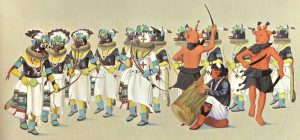Mistaken by Spanish colonizers as satanic worship, the kachina figure was an integral part of the culture of the Pueblo People. Consisting of indigenous tribes including the Hopi, Zuni, Acoma, and Laguna, the Pueblo People occupied much of the Southwestern United States. They were largely farmers and hunters, leaving behind important archaeological sites such as underground kivas, cliff dwellings, pottery, and kachina dolls. These items played an important role in Pueblo religion and culture.
To the Pueblo People, nature was personified as entities known as the kachina. They represented anything from stars to various animals to even other tribes, and tended to be expressed in three ways: as spiritual beings, as masked dancers, and as dolls. The kachina were credited with first teaching humans–specifically the Hopi–how to make tools, hunt, use medicine, and live off the land. To the Pueblo People, the kachina were rain-bringers who stayed with the tribe for half of the year, serving as spiritual guides and influencing the harvest.
Actual ritual worship of the kachina heavily depended on men. Men were the only ones allowed to don kachina masks and dance in the kivas. Kachina masks were thought of as containing a kachina’s spiritual essence, and therefore allowed said kachina to temporarily inhabit the body of the dancer. Through dance, specific spirits would be able to hear the prayers of the people, and men would be able to communicate with the entities themselves.
The second prominent way in which the Pueblo People honored the kachina was with dolls. Originating with the Hopi tribe, sacred kachina dolls were carved from cottonwood roots, which were then painted using natural minerals. These figures were given to young Hopi girls during ceremonies, then hung on walls or used in other ways to decorate and watch over a home. The dolls were often passed down through families, generation after generation. As men were the only ones allowed to participate in kachina ceremonies in underground kivas, kachina dolls served as a way to keep the kachina spirits relevant to the rest of the Pueblo People.
Evidence of kachina art began to appear in the archaeological record as early as 1150 AD, with discoveries in the Puerco Ruins. Definitive representations of kachina in Hopi pottery began appearing in the 1300s, and extended into the 1400s. Similarly, by 1325, there were rock art depictions of kachina masks and dancers. As mentioned earlier, we also see Spanish interaction with the kachina. Colonists’ accounts record seeing “satanic paraphernalia” on display in the homes of Pueblo People–likely these were kachina dolls. Into the mid 1800s and beyond, kachina dolls were sold in the marketplace, and became accessible to non-Pueblo People. Following this, there began to be photo documentation of the kachina dolls and more archaeological research into their history.
Appearing as dolls and in ritual regalia and practices, the kachina held an enormous role in Pueblo society and were an outlet for the agricultural society to pray for good harvests, rains, and natural conditions.
References:
Blake Weiner, James. Kachina Cult. World History Encyclopedia, January 16, 2019, https://www.worldhistory.org/Kachina_Cult/
The Editors of the Encyclopedia Britannica. Kachina. August 30, 2021, https://www.britannica.com/topic/kachina
The Editors of the Encyclopedia Britannica. Pueblo Indians. May 15, 2020, https://www.britannica.com/topic/Pueblo-Indians
Pueblo Native Americans: Their History, Culture, and Traditions. Native Hope, April 19, 2021, https://blog.nativehope.org/pueblo-native-americans-their-history-culture-and-traditions
Weiser-Alexander, Kathy. Kachinas of the Puebloans. Legends of America, November 2021, https://www.legendsofamerica.com/na-kachina/
Further Readings:
Richard H. Wilshusen, Ancestral Puebloans of the Four Corners Region, Colorado Encyclopedia, September 09, 2020, https://coloradoencyclopedia.org/article/ancestral-puebloans-four-corners-region.
Weiser, Kathy. Kachina Types and Ceremonies. Legends of America, November 2019, https://www.legendsofamerica.com/na-kachinatypes/2/



Kachinas continue to be relevant to Indigenous people in the southwest today. How have they changed from their original use? How does their use today help us understand their context in the archaeological record?